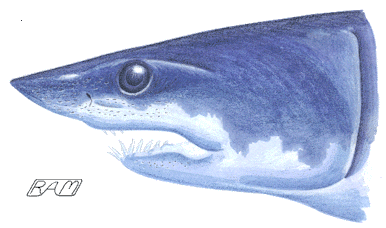Diversity of Feeding Mechanisms
in Sharks
If the awesome dental gymnastics of the Great White are impressive, then the diversity of shark and ray feeding mechanisms are even more so. The earliest sharks had long jaws that were rather firmly anchored to the skull both in front and in back. Therefore, they must have plucked prey from the water column or bottom with forceps-like delicacy and been able to protrude their jaws only minimally. From this seemingly inauspicious start was spawned an astonishing diversity of efficient feeding mechanisms.
 Modern shark feeding mechanisms evolved during the Jurassic Era, about
200 million years ago, and features short jaws that were slung loosely
underneath the skull. Although well attached at the rear of the skull. the
jaws were only weakly attached at the front of the head. This arrangement
enabled these new (and improved) sharks to protrude the upper jaw, opening
up all manner of dietary possibilities. This basic feeding mechanism was
modified in various ways along separate lines of elasmobranch evolution.
Modern shark feeding mechanisms evolved during the Jurassic Era, about
200 million years ago, and features short jaws that were slung loosely
underneath the skull. Although well attached at the rear of the skull. the
jaws were only weakly attached at the front of the head. This arrangement
enabled these new (and improved) sharks to protrude the upper jaw, opening
up all manner of dietary possibilities. This basic feeding mechanism was
modified in various ways along separate lines of elasmobranch evolution.
In the skates (order Rajiformes), for example, the mouth became very small and armed with many small, sharp teeth. The small mouth, combined with an expandable throat cavity, produced a mechanism capable of sucking small bottom-dwelling organisms into the mouth and grasping them with the prickly dentition. The loss of the anterior ligamentous connection between the palatoquadrate (upper jaw) and the skull allowed the upper jaw to aid in directing suction currents. The addition of broader, stronger mollar-like teeth and heavier jaws in the sting and eagle rays (Myliobatiformes) allowed the ancestral "suction-grasping" apparatus to be transformed into a "suction-crushing" one. As a result, myliobatoids became 'nutcracker rays', capable of dealing with hard-shelled molluscs and crustaceans.
Another kind of feeding mechanism was developed early in the dogfishes (Squaliformes). Many of these sharks have short, transverse jaws supported by heavy arches and long processes that extend from the upper jaw. These processes ride against the skull inside the eye sockets, behind the eyes. The teeth in squaloids are often low, sharp, and tightly overlapping to form a continuous edge. This "cutting" feeding apparatus is admirably suited to slicing up prey too large to be swallowed whole.
The "gouging" apparatus found in carcharhinoid and lamnoid sharks — including the Great White — is another basic feeding mechanism. With relatively large jaws and blade-like upper teeth, these sharks can gouge chunks out of prey much larger than themselves. The smoothhound sharks (family Triakidae) have forsaken a sharp-toothed dentition for ray-like molars, developing instead a "crushing" apparatus that is well able to deal with their preferred food — crabs, lobsters, and other crustaceans. The nurse and carpet sharks (Orectolobiformes) have developed a feeding mechanism reminiscent of that found in skates and stingrays. With a small, almost puckered mouth, small-cusped grasping teeth and a huge, expandable throat cavity, these sluggish sharks are adept at sucking bottom-dwelling invertebrates into their mouths.
Perhaps the most spectacular food-gathering adaptation is that found in the "filter-feeding" sharks and rays. In four separate elasmobranch lineages (Rhincodontidae, Megachasmidae, Cetorhinidae, and Mobulidae), the snout is shortened, the mouth is much enlarged, the teeth are greatly reduced in size and significance, and the gill supports have become modified to form plankton sieves. A few groups of sharks and rays depend on structures outside of the mouth to capture prey. The sawfishes (Pristiformes) and sawsharks (Pristiophoriformes) have developed flattened, blade-like snouts armed with lateral teeth with which they disable prey. The electric rays (Torpediniformes) have evolved powerful electrogenic organs that enable them to stun prey. And the thresher sharks (Alopiidae) use their whip-like tail to knock out small schooling fishes and squids, even flipping them into the waiting mouth.
Elasmobranch feeding mechanisms are wondrous in their diversity and certainly contribute significantly to the group's long evolutionary success.
